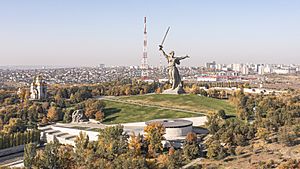Mamayev Kurgan facts for kids
Mamayev Kurgan (Russian: Мамаев Курган) is a big hill overlooking the city of Volgograd in Southern Russia. Its name in Russian means "burial mound of Mamai". This hill is famous for a huge memorial complex that remembers the Battle of Stalingrad. This battle happened from August 1942 to February 1943. It was a very tough win for the Soviet Union against the Axis powers during World War II. The Battle of Stalingrad became one of the deadliest battles in human history. A giant statue called The Motherland Calls stands on the hill. When it was built in 1967, it was the biggest stand-alone sculpture in the world. Today, it is still the tallest statue of a woman in the world.
The Battle for the Hill
When the German Sixth Army attacked the center of Stalingrad on September 13, 1942, Mamayev Kurgan saw very intense fighting. On military maps, the hill was called "Height 102.0". Controlling this hill was super important because it offered a clear view and control over the entire city.
To defend the hill, the Soviets built strong defenses. These included trenches, barbed wire, and minefields on the hill's slopes. The Germans pushed forward, losing many soldiers. When they finally captured the hill, they started shooting at the city center. They also fired at the city's main railway station, which was below the hill. They took over the Volgograd railway station on September 14, 1942.
On the same day, the Soviet 13th Guards Rifle Division arrived in the city. Led by Alexander Rodimtsev, these 10,000 soldiers crossed the Volga River from the east. They came under heavy German artillery fire. The soldiers immediately joined the fight. On September 16, they recaptured Mamayev Kurgan. They also kept fighting for the railway station, but they lost many lives. By the next day, almost all of them had died.
The Soviets kept sending more soldiers into the city as fast as they could. The Germans attacked up to twelve times a day. The Soviets fought back with strong counter-attacks.
The hill changed hands many times during the battle. By September 27, the Germans had captured half of Mamayev Kurgan again. The Soviets held their positions on the slopes of the hill. The 284th Rifle Division defended a key strongpoint there. These defenders held out until January 26, 1943. That's when Soviet forces, who were now attacking, came to help them. The battle for the city ended one week later. It was a complete defeat for the Germans.
After the battle, the soil on the hill was completely messed up. It was churned by bombs and mixed with metal pieces. There were between 500 and 1,250 metal splinters in every square meter. In winter, the earth on the hill stayed black. This was because the snow kept melting from the many fires and explosions. The next spring, the hill was still black because no grass grew on its burned soil. The hill's steep slopes had become flat from months of heavy bombing. Even today, you can still find pieces of bone and metal buried deep in the hill.
The Memorial Complex
After the war, the Soviet government decided to build a huge memorial complex on Mamayev Kurgan. Vasily Chuikov, who led the Soviet forces at Stalingrad, is buried here. He is the only Marshal of the Soviet Union buried outside Moscow. Another famous person buried here is the sniper Vasily Zaytsev, who was reburied in 2006.
The huge memorial was built between 1959 and 1967. At the very top of the hill is a giant statue called The Motherland Calls. This monument was designed by Yevgeny Vuchetich. Its full name is The Motherland Calls! (Russian: Родина-мать зовёт! Rodina Mat Zovyot!). It is a concrete sculpture, 52 meters (about 170 feet) tall. From its feet to the tip of its 27-meter (about 89 feet) sword, it is 85 meters (about 279 feet) tall. This huge statue stands out against the skyline of Volgograd.
The statue is made of concrete, except for the sword's stainless-steel blade. It stands on its base only by its own weight. The statue looks a bit like old Greek statues of Nike, the goddess of victory. Especially the flowing clothes, which are similar to the famous Nike of Samothrace statue.

Images for kids
See also
 In Spanish: Mamáyev Kurgán para niños
In Spanish: Mamáyev Kurgán para niños




